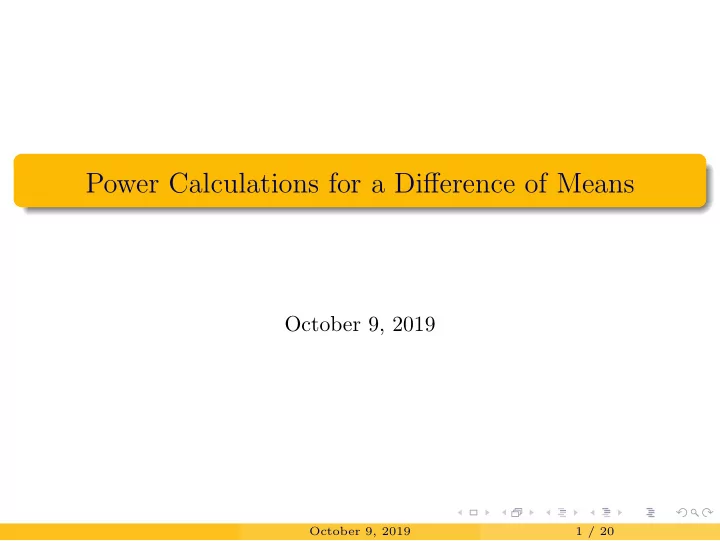

Power Calculations for a Difference of Means October 9, 2019 October 9, 2019 1 / 20
Case Study: Course Exams We have two slight variations of the same exam, randomly assigned to students in a course. Version A Version B n 30 27 ¯ 79.4 74.1 x s 14 20 min 45 32 max 100 100 Is there enough evidence to conclude that one version is more difficult (on average) than the other? Section 7.3 October 9, 2019 2 / 20
Pooled Standard Deviation Our standard error for two-sample means is � σ 2 + σ 2 1 2 SE = n 1 n 2 What if we have reason to believe that σ 1 = σ 2 ? Section 7.3 October 9, 2019 3 / 20
Pooled Standard Deviation Sometimes two populations will have the same standard deviation. We might have a lot of existing data or a well-understood mechanism that justifies this. Sometimes we may also test equality of variances. Section 7.3 October 9, 2019 4 / 20
Pooled Standard Deviation Here we can improve the t-distribution approach by using a pooled standard deviation (pooled variance): pooled = ( n 1 − 1) s 2 1 + ( n 2 − 1) s 2 s 2 2 n 1 + n 2 − 2 Section 7.3 October 9, 2019 5 / 20
Pooled Standard Deviation Then the standard error is � s 2 s 2 pooled pooled + SE ≈ n 1 n 2 with degrees of freedom f = n 1 + n 2 − 2 . d Section 7.3 October 9, 2019 6 / 20
Statistical Error Recall: Type I error: rejecting H 0 when it is actually true. Type II error: failing to reject H 0 when H A is actually true. Section 7.4 October 9, 2019 7 / 20
Adjusting Type II Error We determine how often we commit a Type I error: P (Type I error) = α but what about Type II errors? Section 7.4 October 9, 2019 8 / 20
Adjusting Type II Error We can write P (Type II error) = β but what does that tell us? (Note: β is the Greek letter ”beta”.) Section 7.4 October 9, 2019 9 / 20
Statistical Power Power is the probability that we are able to accurately detect effects. This is the complement of β . There is a trade-off between Type I and Type II error. We can’t set β the way we set α . But we know we can decrease Type II error by increasing sample size. Section 7.4 October 9, 2019 10 / 20
Statistical Power This is another trade-off! We want as much data as possible ...but collecting data can be very expensive. Section 7.4 October 9, 2019 11 / 20
Power Calculations Goal: determine the sample size necessary to achieve 80% power. We will demonstrate using a clinical trial. Section 7.4 October 9, 2019 12 / 20
Example A company has a new blood pressure drug. A clinical trial will test its effectiveness. Study participants are recruited from a population taking a standard blood pressure medication. Control group: standard medication. Treatment group: new medication. Section 7.4 October 9, 2019 13 / 20
Example Write down the hypotheses for a two-sided hypothesis test in this context. Section 7.4 October 9, 2019 14 / 20
Example Want to run trial on patients with systolic blood pressures b/w 140 and 180 mmHg. Existing studies suggest: 1 standard deviation of patients’ blood pressures will be about 12 mmHg. 2 distribution of patient blood pressures will be approximately symmetric. If we had 100 patients per group, what would be the approximate standard error? Section 7.4 October 9, 2019 15 / 20
Example What does the null distribution of ¯ x trt − ¯ x ctrl look like? For what values of ¯ x trt − ¯ x ctrl would we reject the null hypothesis? Section 7.4 October 9, 2019 16 / 20
Example What if we wanted to be able to detect smaller differences? What if instead we had 200 patients in each group? Section 7.4 October 9, 2019 17 / 20
Computing Power For Two-Sample Tests We need to determine what is a practically significant result. We suppose the researchers care about finding a blood pressure difference of at least 3 mmHgn. This is called the minimum effect size . We want to know how likely we are to detect this size of an effect. Section 7.4 October 9, 2019 18 / 20
Example Suppose we decide to use 100 patients per treatment group. The true difference in blood pressure reduction is -3 mmHg. What is the probability that we are able to reject H 0 (given that it’s false)? Section 7.4 October 9, 2019 19 / 20
Example Find the sampling distribution when ¯ x trt − ¯ x ctrl = − 3. Use this to find the probability that we are able to reject H 0 (given that it’s false)? Section 7.4 October 9, 2019 20 / 20
Recommend
More recommend